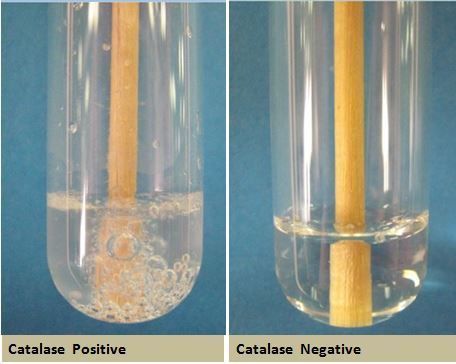
Principle
The enzyme catalase, which is produced by many aerobic and facultative anaerobic microorganisms, neutralizes toxic forms of oxygen metabolites like hydrogen peroxide (H2O2) and superoxide radical (O2–). Catalase mediates the breakdown of H2O2 into oxygen and water and hence protects the cell from bactericidal effect of H2O2.Anaerobes generally don’t produce catalase enzyme. The enzyme is said to be present in a bacterial isolate if the rapid elaboration of oxygen bubbles occurs after the introduction of a small inoculum into hydrogen peroxide (3% for slide test). The lack of or weak bubble production suggests the lack of catalase.
- Strict aerobes and facultative anaerobes are catalase positive. They all have the ability to use oxygen as a terminal electron acceptor.
- Anaerobes and some facultative anaerobes that only ferment and do not use oxygen as a terminal electron acceptor (e.g. Streptococci) are catalase negative.
- Hence, this test differentiates catalase-positive micrococcal and staphylococcal species from catalase-negative streptococcal species
Procedure (Slide Catalase Test):
- Transfer a small amount of colony growth to the surface of a clean, dry glass slide using a loop or sterile wooden stick.
- Place a drop of 3% H2O2 on to the slide and mix.
- Observe for the evolution of oxygen bubbles.
Results:
- Rapid evolution of oxygen (within 5-10 sec.) as evidenced by bubbling is a positive test.
- No or few bubbles produced suggests negative test.

Procedure (Tube Catalase Test)
- Add 4 to 5 drops of 3% H2O2 (Hydrogen peroxide) in a test tube.
- Using a wooden applicator stick, transfer a small amount of colony (well-isolated 18- 24 hour colony) into the test tube.
- Place the tube against a dark background and observe for immediate bubble formation (O2 bubbles) at the end of the wooden applicator stick.
- (Note: Be careful not to pick up any agar (esp if using Blood Agar).- Explanation in precaution below)
Results:
- Catalase Positive reaction: Immediate effervescence (O2 bubble formation)
- Catalase Negative reaction: No effervescence or bubble formation (No catalase present to breakdown H2O2)

Limitations of catalase test: Some bacteria (e.g. enterococci) possess enzymes (like peroxidase) other than catalase that can decompose hydrogen peroxide, with the formation of few tiny bubbles after 20 to 30 seconds, giving false positive.
Precautions:
- Do not use a metal loop or needle with H2O2; it will give a false positive and degrade the metal.
- Don’t scrape any of blood agar while picking up colonies from blood agar plate as red blood cells are catalase positive and any contaminating agar could give a false positive.
- Properly dispose your slide in the bio-hazard glass disposal container.